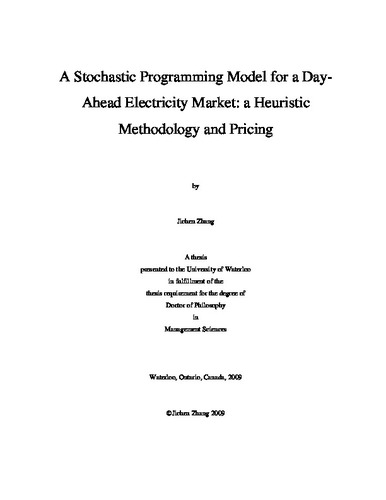| dc.description.abstract | This thesis presents a multi-stage linear stochastic mixed integer programming (SMIP) model for planning power generation in a pool-type day-ahead electricity market. The model integrates a reserve demand curve and shares most of the features of a stochastic unit commitment (UC) problem, which is known to be NP-hard. We capture the stochastic nature of the problem through scenarios, resulting in a large-scale mixed integer programming (MIP) problem that is computationally challenging to solve. Given that an independent system operator (ISO) has to solve such a problem within a time requirement of an hour or so, in order to release operating schedules for the next day real-time market, the problem has to be solved efficiently. For that purpose, we use some approximations to maintain the linearity of the model, parsimoniously select a subset of scenarios, and invoke realistic assumptions to keep the size of the problem reasonable. Even with these measures, realistic-size SMIP models with binary variables in each stage are still hard to solve with exact methods. We, therefore, propose a scenario-rolling heuristic to solve the SMIP problem. In each iteration, the heuristic solves a subset of the scenarios, and uses part of the obtained solution to solve another group in the subsequent iterations until all scenarios are solved. Two numerical examples are provided to test the performance of the scenario-rolling heuristic, and to highlight the difference between the operative schedules of a deterministic model and the SMIP model.
Motivated by previous studies on pricing MIP problems and their applications to pricing electric power, we investigate pricing issues and compensation schemes using MIP formulations in the second part of the thesis. We show that some ideas from the literature can be applied to pricing energy/reserves for a relatively realistic model with binary variables, but some are found to be impractical in the real world. We propose two compensation schemes based on the SMIP that can be easily implemented in practice. We show that the compensation schemes with make-whole payments ensure that generators can have non-negative profits. We also prove that under some assumptions, one of the compensation schemes has the interesting theoretical property of minimizing the variance of the profit of generators to zero. Theoretical and numerical results of these compensation schemes are presented and discussed. | en |

